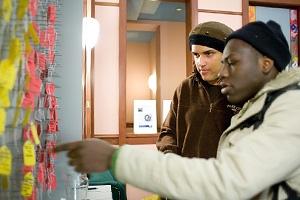December 21, 2009
A conceptual project born out of an Amherst College art course could help fill the gaps for local elderly seeing in-home assistance programs previously subsidized by the state and town disappear.
Thanks to exchange/value, an initiative involving a non-monetary exchange bank and newsletter created by undergraduates in this semester’s “Collaborative Art” class, area senior citizens will soon be able to connect with one another and members of the local and campus communities to, for example, find rides to the doctor’s office or get help grocery shopping—but without paying a dime.
 some of the symbolic deposits at the Keefe banking station. |
“I am incredibly excited about this project,” said Maura Plante, program director of theAmherstSeniorCenterand partner in the initiative. “This is a way that we can all work together to help our elders live independently.”
The idea behind exchange/value is what is called a “parallel economy,” a financial system based not on currency, but exchanging services, explained the college’s Visiting Artist-in-Residence Wendy Ewald, who teamed up with renowned collaborative artist Rick Lowe to teach the course and create the project. “Giving and receiving services instead of money is already so much a part of all of our lives,” she said, citing the simple act of giving a friend a haircut and getting a cup of coffee in return. “exchange/value is all about enabling people to recognize this and building a community of members who believe in the concept.”
Ewald and Lowe knew before teaching the course that a non-monetary exchange bank in some form would not be completely foreign to Western Massachusetts residents; several students in last fall’s “Collaborative Art” joined the nearby North Quabbin Time Bank, a similar initiative that has more than 100 members in the region, and documented their experiences trading services. Their accounts formed the basis of this semester’s class, Ewald said.
Participants in “Collaborative Art” this fall, however, took their predecessors’ work one step further by laying the groundwork for the creation of an exchange bank in Amherst. They did so by reading up on alternative economies, exploring the idea of non-monetary exchange and interviewing seniors, local residents and AmherstCollegestaffers about their individual needs. They then developed an exchange/value newsletter featuring the stories of community members and created two art installation pieces at the college’s Keefe Campus Center and the Amherst Senior Center in town, which include mounted newsletter pages that introduce the concept.
In addition to spotlighting the stories of local residents, the newsletters are meant to be artworks themselves. Based on the business section of The New York Times, and actually overlaid on the section’s pages in many cases, the newsletters as they exist now will provide the basis of a more expanded weekly publication that Amherst students Bessie Young ’11 and Max Kaisler ’11 and Smith College undergraduate Leila Tamari ’11 will launch with the Senior Center in the spring. “We treat monetary exchanges as worthy of news, but not the rest of the exchanges, which represent 50 percent of the transactions that occur as part of theU.S. economy, according to some measures,” said Ewald. “We want people to read and learn more about those other exchanges.”
As for the installation pieces or “banking stations”—which resemble ATM kiosks with pegboards for red and yellow “deposit” and “withdrawal” tags—they will serve as collection points for the goods and services in the spring as well, Ewald continued. Because the undergraduates have left campus for the semester and won’t be able to participate until spring, both the banking stations and the newsletters created by the students in “Collaborative Art” are symbolic for now, she added.
But that pause in momentum hasn’t deterred Ewald and Lowe from setting a goal to get the exchange bank up and running with at least 50 members as soon as possible. “We had to keep asking ourselves, ‘How do we take the work that we’ve done so far and construct it in a way that really addresses meaningfully the way that people sustain their lives through non-monetary exchange?’” said Lowe, adding that he plans to launch an exchange bank in his hometown of Houston. “We have the framework for that conceptually, and now the nuts and bolts are in place. The next step is making it happen.”
Until then, the banking stations will stand as colorful reminders to members of the campus and town communities of what they could be a part of in the spring.
“Collaborative Art” participant Anna Reid ’10, for one, said her work for the course has introduced her to a new way of thinking.
“Hearing people’s stories has given me a new idea of what’s possible and does make me want to engage in things more consciously—and it’s all about consciousness, I think,” she said. “There are things that I do that I didn’t think of before as ‘exchange,’ and bringing this new consciousness to it only makes me more aware of the possibilities.”
For a gallery of photos, go to www3.amherst.edu/~samasinter/TimeBank.